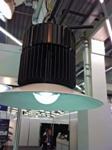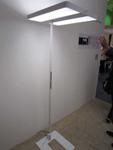EC projects and research
 The EC*s Michael Ziegler, representing the Photonics Unit of DG Connect, spoke about the outcomes from the consultation on the Green Paper on SSL, as previously discussed in LEDs Magazine (www.ledsmagazine.com/features/9/9/3). Ziegler said that two lead markets have been identified to accelerate SSL uptake, namely cities and buildings. In March 2012, the EC established the Task Force on SSL for Cities, with a goal to provide guidelines for SSL deployment in municipalities. The effort will run through to the end of this year. The EC*s Michael Ziegler, representing the Photonics Unit of DG Connect, spoke about the outcomes from the consultation on the Green Paper on SSL, as previously discussed in LEDs Magazine (www.ledsmagazine.com/features/9/9/3). Ziegler said that two lead markets have been identified to accelerate SSL uptake, namely cities and buildings. In March 2012, the EC established the Task Force on SSL for Cities, with a goal to provide guidelines for SSL deployment in municipalities. The effort will run through to the end of this year.
Ziegler*s most interesting slide was an invitation from the EC to the European lighting industry 每 which was well-represented in the SIL Europe audience 每 to undertake various actions, such as creating win-win cooperation platforms. This could include large lighting companies working with SMEs (small and medium enterprises), or the lighting sector working more closely with the building sector, said Ziegler. The EC would also like to see the lighting industry invest in Europe, for example in SSL manufacturing, as well as contributing to the training of lighting designers, electrical installers and resellers.
Ziegler also discussed the EC*s cohesion policy that will encourage ※smart specialization§ and help nations or regions to focus on particular areas of technology. This policy could include funding for key enabling technologies, such as setting up pilot lines for SSL 每 but this would most likely be for OLEDs rather than LEDs.
Michel Quicheron gave an overview of the SSL-related activities conducted by the EC*s Joint Research Centre (JRC). He covered a report on public procurement, which concluded that lighting is often not among priority product groups for such activities. This is due in part to the lack of standards, the wide variety of specifications in the market, and the rapid development of the technology. ※Public procurement has high potential for bringing more LEDs to the market, but public buyers remain cautious towards this technology,§ said Quicheron.
Market surveillance
An ever-increasing number of standards and regulations are being put in place to control the performance of SSL products reaching the European market. However, authorities usually lack the money and resources to enforce the rules. Otmar Franz of the ELC said that market surveillance is necessary to ensure a level playing field. ※Highest-quality, conforming products have their price,§ he said. ※Non-conforming products have lower product-development costs and lower manufacturing costs, which leads to price pressure.§
Franz described some of the activities being carried out by different EU Member States, and said: ※The ELC supports [these activities], but the action from different governments is not focused enough.§ Because of this, the ELC has decided to take complementary action by starting a dedicated market-surveillance project in the EU. This will keep track of market-available products 每 initially the activity will focus just on lamps 每 and will initiate third-party measurements where necessary. Non-compliant products will be flagged up to the relevant authorities for action.
Franz was keen to emphasize that all market participants 每 including ELC members 每 would be treated equally. ※The European market is an open and mature market for all participants wherever they may come from,§ he said, ※but#play to the rules!§
Airport and office lighting
 Several speakers discussed the use of LEDs in different lighting scenarios. Alexander Hanrath of Nualight, a Ireland-based LED lighting supplier, described a lighting project at Schiphol airport in Amsterdam. This massive complex has more than 85,000 fixtures, and the maintenance cost for replacing a single lamp is in the EUR 25-100 ($32-$129) range. Nualight*s Lumoluce subsidiary replaced fluorescent fixtures with linear LED lights that were fitted with the proprietary Wave system. This uses motion-based dimming, enabled by custom-designed passive-infrared (PIR) detectors and dimming drivers. Several speakers discussed the use of LEDs in different lighting scenarios. Alexander Hanrath of Nualight, a Ireland-based LED lighting supplier, described a lighting project at Schiphol airport in Amsterdam. This massive complex has more than 85,000 fixtures, and the maintenance cost for replacing a single lamp is in the EUR 25-100 ($32-$129) range. Nualight*s Lumoluce subsidiary replaced fluorescent fixtures with linear LED lights that were fitted with the proprietary Wave system. This uses motion-based dimming, enabled by custom-designed passive-infrared (PIR) detectors and dimming drivers.
Hanrath explained that the dimming speed and duration is fully configurable, and the dimming is smooth and goes unnoticed by passengers. The cumulative efficiency gains including the Wave system are 68% compared with fluorescent, said Hanrath, and the payback is 2.9 years. The light quality and distribution is also improved. One important point to note, said Hanrath, is that the economic viability of the Wave system is enhanced significantly in regions where labor costs for installation and maintenance are much higher.
Andreas Cereghetti of Switzerland-based Regent Lighting compared office lighting using three different approaches: linear lighting (pendant, surface or recessed), recessed planar lighting, or freestanding uplighters. The latter approach, developed by Regent (Fig. 5), has advantages such as flexibility and individual control of each fixture. Installation and networking are also straightforward.
Regent performed a case study in an open office with 22 uplighters, each with presence detection, daylight sensors, buttons to set the dimming level and to switch on/off individually, and ambient brightness control. This latter feature prevents a situation when one luminaire is lit and the rest of the office is in darkness. Instead, the nearby uplighters are also illuminated at a low level, enabled by a wireless communication network. This improves well-being and comfort, and reduces fatigue due to excessive background contrast levels, said Cereghetti.
The case study showed that overall power consumption was considerably lower than estimated, partly because of the ambient brightness control, partly because desk occupancy was lower than predicted, and partly because of the influence of large windows and daylight sensing.
Biological dimensions of LED lighting
As well as visual effects such as imaging and motion perception, light also conveys non-visual effects such as controlling the body*s circadian rhythm, alertness and well-being. Andreas Wojtysiak of Osram AG described different sets of receptors in the eye, which are either visual receptors (rods and cones) or biological receptors (ipRGCs). These ipRGCs are responsible for, among other things, day/night detection to control the body*s inner clock. The ipRGCs are located in the lower part of the retina and are stimulated most effectively by wide-area light sources from above 每 in nature, of course, this means the sky. Wojtysiak said that broad-area ceiling lights would do a much better job of boosting the alertness of the conference audience, rather than the spotlights that were in use in the auditorium.
Fenella Frost of PhotonStar LED extended this discussion by emphasizing that blue light at around 460 nm is the critical wavelength that controls biological effects. ※Blue light suppresses melatonin production and promotes wakefulness,§ said Frost. Thus, it can be beneficial in the morning to have a light source with a high blue content (such as a cool-white LED source), but in the evening this source can disrupt the natural cycle and make sleep difficult. The latter effect is seen when people use LCD screens late into the night, and are affected by the blue-light content of the backlights.
In contrast, correlated color temperature (CCT) on its own has limited biological effect, although people often select cool-white light in the morning to boost alertness, and warm-white light in the evening to help with relaxation. However, explained Frost, if this warm-white source is LED-based, it may still have a high blue-light content, which is not conducive to sleep. The solution could be a variable LED source that can be adjusted to produce warm-white light with a low-level blue component, for evening use.
|

 English
English  Chinese
Chinese 





 English
English  Chinese
Chinese 



